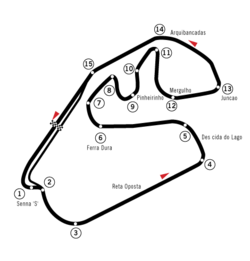Autódromo José Carlos Pace

| |
| Autódromo José Carlos Pace | |
|---|---|
| Location | |
| Events | Formula One |
| Length km | 4.309 |
| Length mi | 2.677 |
| Turns | 15 |
| Record time | 1'11.473 |
| Record driver | Juan Pablo Montoya |
| Record team | Williams-BMW |
| Record year | 2004 |
Autódromo José Carlos Pace is the venue of the Formula One Brazilian Grand Prix, located in a suburb of the city of São Paulo, named after José Carlos Pace, a Brazilian Formula One driver, who had died prior to its naming. It is still widely known by its former name, Interlagos. The neighbourhood is also known as Interlagos, from its proximity to the circuit.
History
The land on which the circuit is built was originally bought in 1936 by property developers who wanted to build accommodation. However, it was discovered that the land was unsuitable for housing, so a racing circuit was built instead.
The traditional name of the circuit (literally, "between lakes") comes from the fact that it was built in a region between two large artificial lakes, Guarapiranga and Billings, which were built in the early 20th century to supply the city with water and electric power. In the 1970s it was renamed to honor the then recently deceased Formula One driver José Carlos Pace. There is a kart circuit inside it named after Ayrton Senna.
Characteristics
The circuit is one of the few racing circuits outside of the United States to go in an anti-clockwise direction (Autodromo Enzo e Dino Ferrari and Istanbul Racing Circuit are the two other counter-clockwise tracks to be used in recent years by Formula One.)
The present design of the track dates back from 1990, when the original circuit was shortened from 7,829 m to only 4,397 m (so that it could fit the new FIA restrictions on track length). As a consequence of the reduction, the track lost three long straight sections and three fast curves (another one was reversed and one created). The original track allowed cars to keep maximum speed for up to twenty seconds and was considered very dangerous (though no one ever died there racing Formula One). The new track still has a very long top-speed section that contains bumps, high-speed turns and little run-off area (though the track is very wide at this point).
Another reason why most pilots consider Interlagos interesting is that it was not built on plain terrain, but adapting itself to ups and downs of a hilly ground, which makes it harder to drive and demands more power from the car's engines.
Facilities
Facilities, organisation and general safety at Interlagos and its surroundings are often criticised. Notably, during a qualifying session in 2000, the session had to be stopped three times due to advertising hoardings falling onto the track - one straight into the path of Jean Alesi's Prost car. A practice session before the race in the 2004 season had to be stopped because a stray dog had found its way onto the track. The circuit is also criticised for being very bumpy. Despite attempts to smooth the surface, drivers still complain.
The old track was unfortunately completely abandoned and is now in disrepair, as no racing category ever manifested any interest on racing in it.
Track Course

Race start is in front of the "Tribunas" section and features a pretty long straight section, then comes "S do Senna" ("Senna's S"), a series of turns (left, right, then left again) that are considered extremely difficult because each of them has a different angle, a different radius, a different length, a different inclination (inward or outward) and a different shape (besides the terrain goes down and then up again).
"Senna's S" connects with "Curva do Sol" ("Sun Turn"), a round-shaped large-radius left-turn that leads to "Reta Oposta", the track's longest (but not the fastest) straight line. Reta Oposta is succeeded by two leftwise, uphill turns that are called "Subida do Lago" ("Up to the Lake") and then "Mergulho" ("Dive"), a short straight sector that goes down again.
After "Mergulho" comes a slow and difficult section, with small, kart-like turns and unpredictable ups-and-downs. These turns are "Ferradura" ("Horseshoe") rightwise and downhill in two steps; "Pinheirinho" ("Pine Tree"), an S-type section (right, then left) on a plain field; "Bico de Pato" ("Duck's Beak"), two rightwise turns (one easy, the other very slow and difficult); and then two leftwise turns forming a section called "Junção" ("Junction").
After the slow section begins the long, thrilling and dangerous top-speed section. The first step is "Subida dos Boxes" ("Up to the Pits"), a long, left-wise turn that sometimes seems straight and sometimes bends in more clearly. As the name implies, Subida dos Boxes is uphill (quite steep, indeed) and demands a lot of power from the cars. At the end of it there are two turns (14 and 15) that form what was once called "Cotovelo" ("Elbow"). At this point the track seems inclined inwards (or somewhat crooked).
Pit Lanes
Interlagos has one of the longest pit-lanes ever used in Formula One, starting just before the start line and rejoining the main course after Curva do Sol. Entering the pits is not a trivial task, as the high speed and the left turning may force the car rightwards, out of the pits.
References and external links
- The Official Formula 1 Website. Retrieved 2005-08-31
- Official Brazilian Grand Prix website
- Autodromo Jose Carlos Pace History and Statistics
- Satellite picture by Google Maps
- Ciro Pabón's Racetracks 3D views and virtual laps of all F1 circuits, including this one, via Google Earth